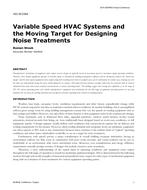-
-
Available Formats
- Options
- Availability
- Priced From ( in USD )
-
Available Formats
-
- Immediate download
-
$16.00Members pay $7.00
- Add to Cart
Customers Who Bought This Also Bought
-

HO-18-C030 -- Analysis of Load Diversity in China Residen...
Priced From $16.00 -

HO-18-C043 -- Analysis of Spread Index: A Measure of Labo...
Priced From $16.00 -

HO-18-C054 -- Variable Speed HVAC Systems and the Moving ...
Priced From $16.00 -

HO-18-C009 -- Assessing the Risk of Overheating in High-P...
Priced From $16.00
About This Item
Full Description
ASHRAE Standard 62.1, developed as a design standard, is cited as a basis for evaluating minimum outside air flow rates in existing buildings byrating systems including LEED EB O&M, ENERGY STAR and ASHRAE Building EQ. Engineers charged with documenting complianceunder these rating systems often find this task to be confusing and onerous, due to lack of available data on existing air distribution systems necessary toperform the calculations. A proposed modification to the standard (Addendum f) provides a simplified method for calculating required minimum outsideair flow. This paper presents the results of a comparative analysis between this simplified approach and the full calculation using Appendix A, with datafrom 98 systems in 13 office buildings throughout the U.S., varying in climate zone, building age, and HVAC system type. The authors worked withthese buildings previously in their LEED certification processes. Ventilation rates determined using proposed Addendum f meet or exceed those usingAppendix A for 97% of systems studied; the median increase in ventilation airflow per system was 21%. The divergence between the two methods isgreater for systems with low occupant diversity ratios. The affect of this divergence on energy cost and carbon emissions varies by location, but is generallyminimal; occupant health and productivity will benefit from improved indoor air quality.





